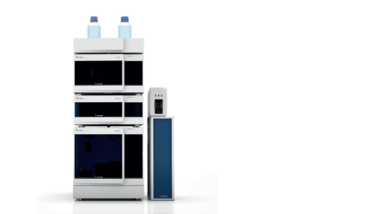
Superior Size Separation
KNAUER AZURA GPC/SEC systems are designed to optimize both the user experience – and the end results
sponsored by Knauer

Characterizing polymers and biomolecules is essential to many areas of research – from understanding new materials to fighting pandemics. The separation technique of choice? Depending on your application (or your background), you may call it gel-permeation chromatography (GPC), size-exclusion chromatography (SEC) or gel-filtration chromatography (GFC). We spoke to Hanna-Maija Hiltunen to hear how KNAUER’s AZURA GPC/SEC systems allow chromatographers to wield size-based separation techniques with the utmost precision.
For the uninitiated, what is SEC and how is it typically applied?
In short, SEC separates analytes by size using special columns with a porous matrix. The basic separation principle relies on the fact that smaller molecules will be more likely to enter those pores, making their travel through the matrix longer than that of larger molecules. Separations (typically of a mixture of polymers, polysaccharides or biomolecules) are facilitated by choosing optimal particle and pore sizes, as well as column length. SEC is often used in quality control and R&D.
What are KNAUER’s key GPC/SEC offerings?
Our AZURA GPC/SEC systems are the newest addition to our chromatography portfolio. AZURA GPC/SEC systems incorporate the well-established KNAUER pump and detector technology from our analytical HPLC systems but optimized and configured to meet the requirements of GPC/SEC applications.
Can you explain your definition of GPC/SEC?
That’s a good question! We are trying to be as inclusive as we can within the constraints of confusing terminology. GPC, GFC and SEC all essentially describe the same methodology, but the term GPC tends to be used in polymer chemistry by those working with aggressive, organic solvents, while SEC and GFC are more commonly used by those separating biomolecules using aqueous solvents (buffers) or to reflect the use of aqueous buffers in polymer separations. Whether working with organic solvent- or aqueous-based systems, there are some inherent system challenges. The solvents used in polymer analysis are chosen for their ability to dissolve polymeric substances – and therefore may damage certain components of a device. And the use of salt buffers in SEC is harmful to metal components of the system. Hence, all liquid-contacting system components, from the valves and seals to tubing, must be carefully considered when developing such systems.

The AZURA GPC/SEC system
What other challenges does GPC/SEC pose for chromatographic systems – and how does AZURA fit the bill?
In addition to the aforementioned system material requirements, GPC/SEC analyses necessitate lower flow rates and lower pressure than HPLC. GPC/SEC runs are conducted isocratically, so a good isocratic pump is essential for a steady baseline – and the AZURA’s excellent isocratic pump has been specifically optimized to meet the requirements of GPC applications.
We’ve also put a great deal of thought into optimizing the AZURA RI detector, with a focus on increasing the detector performance using organic solvents. However, our GPC/SEC systems can also be configured to use a UV/Vis detector – there is the choice between variable single wavelength detectors, multi-wavelength detectors and diode array detectors.
AZURA also affords customers the flexibility to extend their GPC/SEC systems with autosamplers, valves, feed pumps, and column thermostats. In fact, many GPC runs are conducted at higher temperatures (~60°C), so the AZURA column thermostat is of great interest.
Can you tell us more about the columns used in GPC/SEC?
The stationary phase in GPC/SEC applications is crucial. GPC/SEC separation efficiency is driven by long columns with large diameters, and the matrix is often based on porous silica or polymer material – the pore size determines the molecular weight range of the separation, and columns with different pore sizes are combined to broaden the separation range and increase resolution.
We’ve developed a great partnership with a local GPC/SEC column manufacturer called AppliChrom by combining our AZURA GPC/SEC portfolio with AppliChrom columns. This is a great way to bring our tremendous expertise in these areas together for the ultimate customer experience.
How about software? We hear you offer a special ClarityChrom module for GPC/SEC clients…
The software requirements for GPC/SEC are a little different to HPLC. In GPC/SEC, the main goals are the determination of molar mass averages and the distribution of molar masses, which is performed through calibration using general standards with molar masses in a given range. The user chooses the standard according to the molar mass range they expect their molecules of interest to lie within.
The software then assigns retention times/volumes to a molar mass. Many chromatography data systems (CDS) are incapable of this feature, leading to a reliance on sometimes unfamiliar, independent software packages. Data Apex has developed a GPC/SEC module based on ClarityChrom – especially beneficial for those users who are already familiar with our CDS!
Visit www.knauer.net/GPC for more information.












